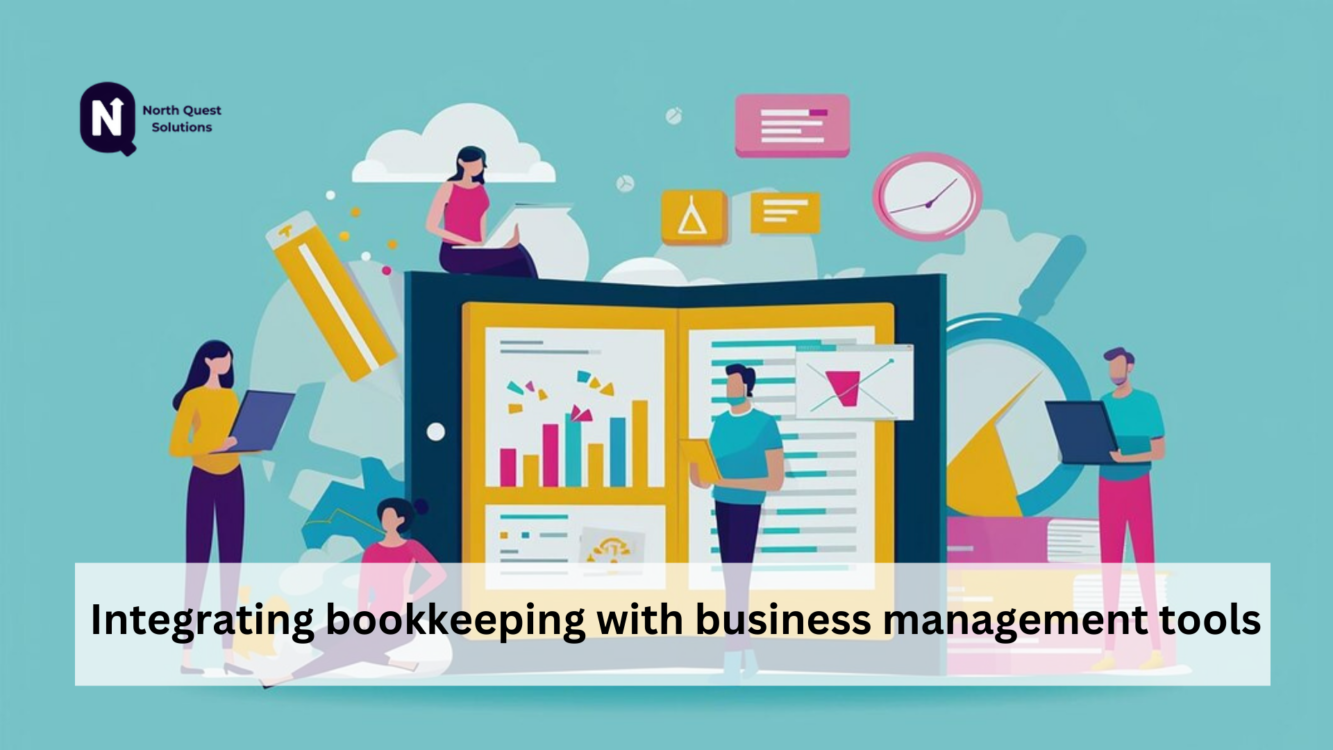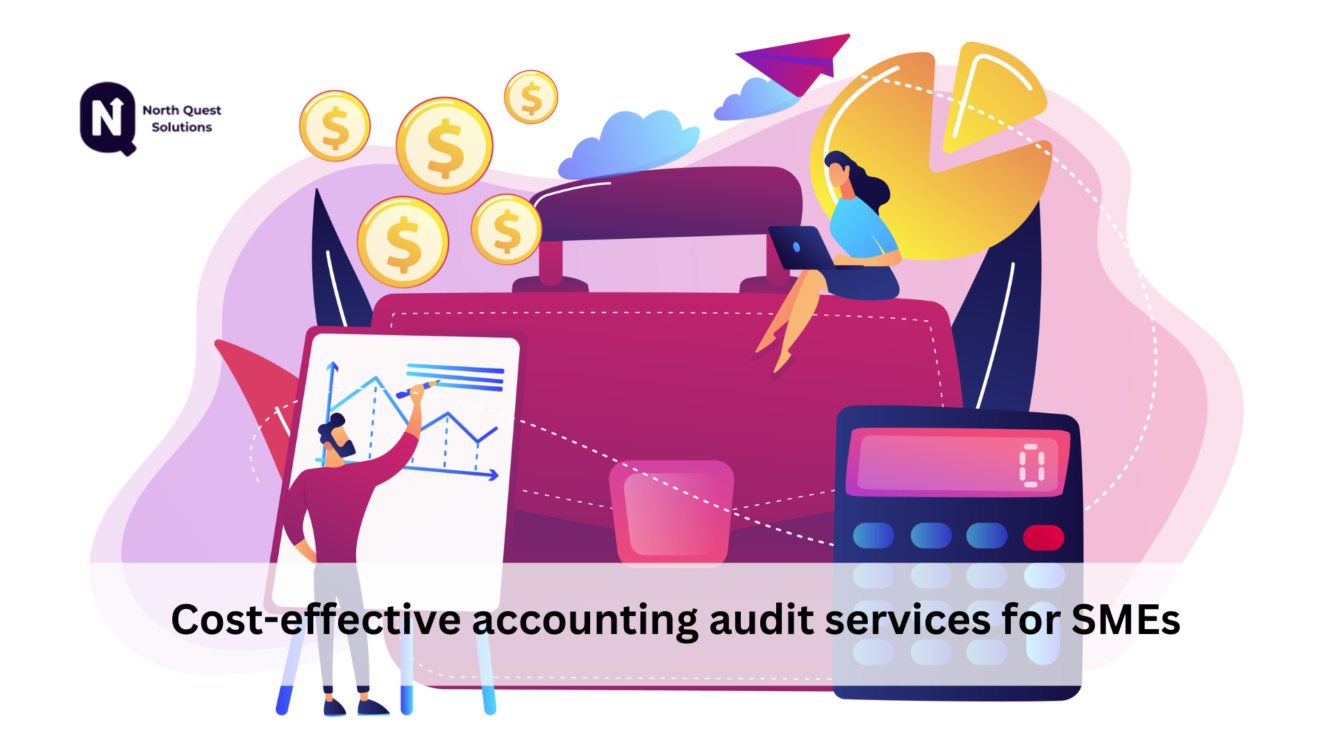Integrating Bookkeeping Service with business management tools
In the ever-evolving panorama of enterprise management, efficiency is paramount. North Quest Solutions understands this well. As a main issuer of modern solutions, North Quest Solutions recognizes the significance of integrating bookkeeping services seamlessly with commercial enterprise management equipment. This integration now not best streamlines operations but additionally enhances selection-making techniques, in the end, main to sustained increase and achievement. Understanding Bookkeeping Service: Bookkeeping Service is the backbone of economic management for any enterprise. It includes recording monetary transactions, preserving correct facts, and generating economic statements. While important, traditional bookkeeping strategies can be time-consuming and prone to mistakes. Hence, leveraging the era to automate and combine bookkeeping strategies turns into imperative. The Role of Business Management Tools: Business management equipment embodies a huge variety of software programs designed to streamline diverse factors of operations, including mission control, consumer dating management (CRM), and economic control. These gear provide functionalities that permit organizations to effectively manage sources, screen overall performance, and make informed choices. Integration Benefits for North Quest Solutions: Enhanced Accuracy: Integrating bookkeeping offerings with commercial enterprise management gear minimizes the hazard of mistakes related to guide data entry. Automation ensures that economic records are accurately recorded and updated in actual time, imparting North Quest Solutions with reliable insights into its financial fitness. Time Efficiency: By automating repetitive bookkeeping obligations, personnel at North Quest Solutions can be aware of their time and electricity on extra strategic sports. This now not simplest will increase productiveness but additionally allow for higher usage of resources, riding standard performance. Seamless Data Accessibility: Integration facilitates seamless records glide among distinct structures, casting off the need for manual records transfer and lowering the likelihood of fact discrepancies. This guarantees that stakeholders have get right of entry to up-to-date monetary facts on every occasion and wherever they need it. Improved Decision Making: Timely and accurate monetary facts are important for knowledgeable decision-making. With integrated bookkeeping offerings, North Quest Solutions can generate comprehensive reviews and economic analyses at the clicking of a button, empowering control to make strategic choices with confidence. Implementation Strategies: Identify Compatible Tools: North Quest Solutions has to compare and select commercial enterprise control gear which are well matched with its existing bookkeeping gadget. This ensures clean integration and minimizes disruptions to operations. Customize Integration: Tailoring the mixing method to fulfill the unique desires and necessities of North Quest Solutions is important. This may additionally involve configuring settings, mapping facts fields, and organizing workflows to make certain seamless statistics exchange between systems. Employee Training: Proper schooling and schooling are vital to make certain that personnel are proficient in using integrated structures successfully. North Quest Solutions has to put money into training packages to familiarize a group of workers with the brand-new processes and functionalities. Continuous Monitoring and Optimization: Integration is an ongoing system that requires everyday tracking and optimization. North Quest Solutions needs to periodically review its included systems to identify areas for improvement and implement updates or changes as wanted. Case Study: North Quest Solutions’ Success Story North Quest Solutions, a rapidly developing IT consulting company, recognized the need to streamline its monetary management tactics to support its enlargement efforts. By integrating its bookkeeping offerings with superior commercial enterprise management tools, North Quest Solutions performed awesome consequences. Increased Efficiency: Automation decreased manual efforts via forty, permitting personnel to focus on strategic initiatives. Enhanced Accuracy: Real-time information synchronization minimized mistakes and stepped forward the reliability of monetary reports. Informed Decision Making: Comprehensive economic analyses furnished control with valuable insights for strategic selection making, main to expanded profitability and boom. Conclusion: Integrating bookkeeping services with business control gear is essential for maximizing efficiency and using growth in a modern day competitive commercial enterprise environment. North Quest Solutions‘ commitment to leveraging technology to streamline its monetary management tactics exemplifies the importance of embracing innovation to obtain fulfillment. By enforcing integration techniques tailored to its particular needs, North Quest Solutions has positioned itself for sustained boom and prosperity within the years yet to come.
Read MoreMaximize Your Profits with Bookkeeping Services for Freelancers and Entrepreneurs
In the fast-paced world of freelancing and entrepreneurship, handling finances efficaciously is paramount. As a freelancer or entrepreneur, staying on top of your bookkeeping can be challenging amidst the myriad of tasks that traumatic your interest. That’s where North Quest Solutions steps in, presenting comprehensive bookkeeping offerings tailored to satisfy the specific needs of freelancers and marketers. Bookkeeping Services: The Key to Financial Success Bookkeeping service serves as the cornerstone of economic achievement for freelancers and entrepreneurs. It is going past mere quantity-crunching, offering priceless insights into your business’s monetary fitness and allowing knowledgeable selection-making. Understanding the Importance of Bookkeeping Effective bookkeeping empowers freelancers and entrepreneurs to: Streamline Financial Operations By outsourcing bookkeeping obligations to experts like North Quest Solutions, freelancers and marketers can streamline their monetary operations, liberating up time to consciousness on center enterprise activities. Maintain Compliance Compliance with tax rules and monetary reporting necessities is crucial for freelancers and marketers. Professional bookkeeping offerings ensure adherence to prison obligations, warding off consequences and felony hassles. Gain Strategic Insights Accurate economic data offer valuable insights into enterprise overall performance, supporting freelancers and entrepreneurs to identify strengths, weaknesses, and possibilities for increase. The Role of North Quest Solutions As a leading provider of bookkeeping services, North Quest Solutions offers quite several solutions designed to meet the diverse wishes of freelancers and marketers. Tailored Solutions North Quest Solutions is aware that each commercial enterprise is unique. They offer customized bookkeeping solutions tailor-made for your precise requirements, ensuring maximum efficiency and accuracy. Advanced Technology Utilizing contemporary generation and accounting software, North Quest Solutions offers seamless bookkeeping services, minimizing mistakes and optimizing techniques. Conclusion In conclusion, powerful bookkeeping is critical for the monetary fulfillment of freelancers and entrepreneurs. By partnering with North Quest Solutions, you may streamline your economic operations, hold compliance, and gain precious insights into your commercial enterprise’s overall performance. Don’t permit bookkeeping responsibilities to weigh down you; allow North Quest Solutions to take care of them while you focus on developing your business.
Read MoreAdvantages of outsourcing Bookkeeping Service
Bookkeeping Service forms the spine of any commercial enterprise, offering crucial financial insights for knowledgeable choice-making. However, dealing with bookkeeping in residence may be bulky and time-consuming. Outsourcing this mission to specialized firms like North Quest Solutions gives numerous advantages, permitting companies to focus on their middle operations at the same time as ensuring economic balance and compliance. Cost Efficiency Reduced Overhead Costs Outsourcing bookkeeping offerings enables businesses to seriously reduce overhead expenses associated with hiring and preserving an in-residence accounting crew. With North Quest Solutions, corporations can save on salaries, benefits, training expenses, and workplace areas, leading to huge fee savings. Access to Skilled Professionals By partnering with North Quest Solutions, agencies gain get right of entry to a group of particularly skilled and skilled bookkeeping professionals. These specialists convey enterprise know-how and high-quality practices to the table, making sure accurate economic records and compliance with regulatory requirements. Focus on Core Business Time-saving Opportunities Outsourcing bookkeeping tasks frees up precious time for enterprise owners and bosses to be aware of core enterprise activities. Instead of allocating sources to non-core capabilities like bookkeeping, organizations can direct their efforts in the direction of increased techniques, innovation, and consumer delight. Enhanced Focus on Core Operations With North Quest Solutions dealing with bookkeeping duties, companies can streamline their operations and decorate productiveness. By delegating repetitive and time-consuming duties, groups can focus on delivering prices to clients and staying ahead in the aggressive market. Scalability Flexibility in Resource Allocation Outsourcing bookkeeping gives organizations the flexibility to scale resources in keeping with their desires. Whether experiencing a speedy boom or brief fluctuations, North Quest Solutions adapts its services to house-converting enterprise requirements, ensuring sure most desirable performance and cost-effectiveness. Easy Adjustment to Business Growth As groups enlarge, their bookkeeping desires evolve. North Quest Solutions presents scalable solutions that seamlessly align with commercial enterprise growth, offering custom-designed offerings tailored to the size and complexity of the enterprise. Expertise and Accuracy Access to Specialized Knowledge Partnering with North Quest Solutions offers companies access to specialized know-how and expertise in bookkeeping and accounting practices. This guarantees correct monetary reporting, compliance with enterprise regulations, and strategic economic planning for long-term fulfillment. Minimization of Errors By outsourcing bookkeeping to North Quest Solutions, organizations minimize the threat of errors and discrepancies in their monetary statistics. With rigorous best control measures in the area, North Quest Solutions guarantees accuracy and reliability in all economic transactions. Technological Advancements Integration of Advanced Software North Quest Solutions leverages contemporary technologies and accounting software programs to streamline bookkeeping procedures. By automating routine responsibilities and enforcing cloud-based solutions, businesses advantages from the real-time right of entry to monetary statistics and more suitable collaboration. Enhanced Data Security Security is paramount in monetary information. North Quest Solutions prioritizes records safety via enforcing sturdy encryption protocols, secure servers, and stringent get right of entry to controls, ensuring the confidentiality and integrity of touchy financial statistics. Streamlined Processes Simplified Workflow Outsourcing bookkeeping to North Quest Solutions simplifies commercial enterprise workflows, getting rid of the need for manual records access and reconciliation. With automated techniques and standardized processes, groups can achieve more efficiency and accuracy in their economic operations. Improved Reporting Capabilities North Quest Solutions presents comprehensive financial reviews and insights that permit organizations to make knowledgeable choices. With custom-designed reporting templates and actual-time analytics, agencies advantage of valuable insights into their financial overall performance and regions for improvement. Compliance and Regulations Adherence to Legal Requirements Staying compliant with ever-changing guidelines can be difficult for businesses. North Quest Solutions ensures adherence to all felony necessities, together with tax laws, economic reporting requirements, and enterprise regulations, minimizing the threat of penalties and fines. Reduction of Compliance Risks Outsourcing bookkeeping to North Quest Solutions reduces the burden of compliance control on agencies. With expert guidance and proactive compliance measures, corporations can mitigate dangers and keep regulatory compliance without difficulty. Enhanced Decision Making Data-Driven Insights Access to accurate and up-to-date monetary information empowers groups to make statistics-driven selections. North Quest Solutions provides complete financial evaluation and insights, permitting groups to perceive tendencies, examine performance, and expand strategic growth plans. Strategic Financial Planning With North Quest Solutions managing bookkeeping obligations, groups can attention to strategic economic making plans and goal-putting. By analyzing financial developments and forecasting destiny performance, agencies could make informed choices that drive sustainable increase and profitability. Customer Satisfaction Improved Service Delivery Outsourcing bookkeeping frees up resources that may be allotted to enhancing carrier shipping and customer satisfaction. By specializing in turning in brilliant products and services, organizations can enhance customer loyalty and advantage in an aggressive area inside the market. Better Customer Experience Efficient bookkeeping techniques ensure well-timed invoicing, correct billing, and transparent financial transactions, main to a better general customer experience. With North Quest Solutions coping with monetary operations, agencies can build agreement with and credibility with their customers. Case Studies Real-lifestyles Examples Numerous agencies have experienced vast advantages via outsourcing their bookkeeping to North Quest Solutions. Case research showcases how organizations have achieved value financial savings, operational efficiency, and strategic boom through partnership with North Quest Solutions. Success Stories From startups to mounted organizations, groups throughout industries have carried out terrific success with North Quest Solutions. Success memories spotlight the transformative effect of outsourcing bookkeeping on business overall performance, profitability, and sustainability. Conclusion In conclusion, outsourcing bookkeeping to North Quest Solutions gives myriad advantages for organizations searching for to optimize their operations and force boom. From value performance and scalability to knowledge and compliance, partnering with North Quest Solutions enables groups to be cognizance of their center strengths even as making ensure economic balance and strategic decision-making.
Read MoreHow to choose the right bookkeeping service
In brand-new fast-paced business surroundings, maintaining correct economic data is paramount for success. As companies grow, so do their bookkeeping wishes. Choosing the proper bookkeeping provider can substantially impact the efficiency and economic health of your enterprise. Understanding Your Needs Before diving into the choice process, it’s vital to apprehend your precise bookkeeping requirements. Whether it is fundamental transaction recording or complicated financial analysis, knowing what you want will help narrow down your options. Researching Options Explore the various range of bookkeeping offerings to be had inside the market. Consider elements along with employer length, enterprise know-how, and carrier offerings to discover providers that align together with your enterprise’s desires. Assessing Expertise Evaluate the knowledge and experience of ability bookkeeping provider providers. Look for certifications, industry enjoy, and consumer testimonials to gauge their competency in dealing with your monetary facts. Checking Reviews Delve into reviews and testimonials from beyond customers to get insights into the pleasant of providers provided via bookkeeping corporations. Pay attention to feedback regarding accuracy, timeliness, and verbal exchange. Comparing Pricing Plans Compare pricing structures and applications presented via unique bookkeeping services. Ensure that the price aligns with your budget at the same time as also thinking about the level of service and expertise furnished. Inquiring About Software Check compatibility with your selected accounting software. Ensure that the bookkeeping carrier utilizes systems that integrate seamlessly together with your present structures for smooth record transfer and collaboration. Assessing Customer Support Evaluate the excellent responsiveness of customer service offered by bookkeeping offerings. Prompt and effective conversation is important for addressing any troubles or concerns that may arise. Ensuring Data Security Verify the safety measures implemented via bookkeeping offerings to shield touchy financial records. Look for encryption protocols, statistics backup strategies, and compliance with industry regulations. Seeking Referrals Seek pointers from dependent on resources which include commercial enterprise pals, enterprise friends, or professional networks. Personal referrals can provide precious insights and help slender down your alternatives. Negotiating Terms Negotiate phrases and situations to tailor the bookkeeping provider to your specific business desires. Discuss pricing, provider degree agreements, and any extra necessities to make certain a mutually beneficial partnership. Signing the Contract Finalize the settlement and sign the contract with the selected bookkeeping carrier. Ensure that all phrases are truly outlined and understood to keep away from any misunderstandings down the road. Conclusion Selecting the proper bookkeeping service is a crucial choice that can have an enormous effect on your business’s monetary fitness and achievement. By expertise in your needs, getting to know alternatives, and comparing vendors very well, you can make an informed choice that sets your enterprise up for long-term increase and prosperity. More information:- North Quest Solutions
Read MoreMaximize Efficiency with Online Bookkeeping Services for Small Businesses
In the quick-paced world of small business operations, effective Bookkeeping Service is paramount. Small agencies often battle to allocate resources to manipulate their price range effectively. However, with the appearance of online bookkeeping offerings, marketers can now leverage technology to streamline their financial control methods. In this text, we delve into the world of online bookkeeping offerings, specializing in how North Quest Solutions may be the precise partner for small companies searching for reliable bookkeeping answers. Bookkeeping Service: Streamlining Financial Management In the cutting-edge digital age, conventional bookkeeping methods are being changed by more efficient online solutions. North Quest Solutions offers comprehensive online bookkeeping services tailor-made mainly for small agencies. These services encompass an extensive range of financial control tasks, including: Automated Data Entry and Organization Gone are the times of guide facts entry and office work. With North Quest Solutions’ online bookkeeping offerings, small corporations can automate their information access strategies, making sure correct and prepared economic data. Real-Time Financial Reporting Access to actual-time monetary reports is important for small business proprietors to make informed choices. North Quest Solutions gives intuitive structures that provide up-to-date financial insights, enabling entrepreneurs to song their business performance results easily. Tax Preparation and Compliance Navigating the complexities of tax instruction may be daunting for small business proprietors. With North Quest Solutions, entrepreneurs can rest confident that their tax responsibilities are met as they should be and on time, way to the expertise of pro specialists. Payroll Management Managing payroll can be time-consuming and mistakes-susceptible. North Quest Solutions simplifies payroll control with computerized structures that ensure timely and correct employee payments. The Benefits of Outsourcing Bookkeeping Services Outsourcing bookkeeping services to North Quest Solutions offers small businesses a myriad of advantages, including: Cost Savings By outsourcing bookkeeping tasks, small businesses can shop on overhead expenses associated with hiring and schooling in-residence groups of workers. North Quest Solutions gives flexible pricing plans tailor-made to fit the budgetary constraints of small agencies. Focus on Core Business Activities Outsourcing bookkeeping allows entrepreneurs to attention their time and energy on center enterprise sports, which includes product improvement and consumer acquisition, main to multiplied productivity and growth. Access to Expertise With North Quest Solutions, small organizations advantage get admission to a team of experienced bookkeeping specialists who own the information to address complex monetary duties with precision and efficiency. Scalability As small corporations grow, their bookkeeping wishes evolve. North Quest Solutions offers scalable solutions that may adapt to the changing needs of companies, making sure seamless integration and endured assistance. North Quest Solutions: Your Trusted Partner in Bookkeeping When it involves online bookkeeping services for small corporations, North Quest Solutions sticks out as a trusted partner. With their commitment to excellence and innovation, North Quest Solutions empowers small companies to thrive in present-day aggressive panorama. Conclusion In the end, online bookkeeping offerings offer small corporations a handy and green strategy for their financial control wishes. With North Quest Solutions, entrepreneurs can streamline their bookkeeping strategies, lessen prices, and attention to growing their companies. Don’t permit bookkeeping responsibilities to weigh you down—accomplice with North Quest Solutions and take your small enterprise to new heights.
Read MoreUnlocking the Future: Trends in Accounting Audit Technology and Methodologies
In a state-of-the-art unexpectedly evolving commercial enterprise panorama, the sector of accounting audit era and methodologies is experiencing groundbreaking modifications. With the advent of advanced technologies and progressive methodologies, auditors are empowered to beautify the performance, accuracy, and reliability of their practices. This article delves into the emerging tendencies shaping the destiny of the accounting audit era and methodologies, presenting insights into the dynamic nature of the industry. Navigating the Digital Era: Leveraging Technology in Auditing In the digital age, technology serves as a cornerstone for revolutionizing accounting audit practices. From automatic records analysis to synthetic intelligence (AI)–push auditing tools, technological improvements are streamlining processes and augmenting auditors’ abilities. Cloud-based total audit structures, equipped with sturdy security functions, facilitate seamless collaboration and information control, transcending geographical boundaries. Moreover, blockchain generation is gaining traction for its ability to decorate transparency and integrity in economic audits, ensuring the immutability of transaction facts. Harnessing Data Analytics for Enhanced Insights Data analytics emerges as a pivotal trend in revolutionizing accounting audit methodologies. By harnessing the electricity of large records and predictive analytics, auditors can glean treasured insights from widespread datasets, enabling proactive risk identity and mitigation techniques. Advanced analytics gear empowers auditors to detect anomalies, traits, and patterns with unheard-of precision, facilitating greater informed choice-making strategies. Moreover, gadget-getting-to-know algorithms enable non-stop tracking of monetary transactions, bolstering audit efficiency and efficacy. Embracing Automation for Operational Efficiency Automation emerges as a driving pressure at the back of the evolution of accounting audit methodologies, permitting auditors to streamline repetitive obligations and focus on high-value activities. Robotic process automation (RPA) technologies automate guide processes, consisting of data access and reconciliation, decreasing the threat of human blunders and improving audit accuracy. Additionally, cognitive automation tools leverage natural language processing (NLP) abilities to extract insights from unstructured information, expediting audit tactics and improving compliance with regulatory requirements. Augmented Reality: Transforming Audit Fieldwork The integration of augmented truth (AR) technology is reshaping conventional audit fieldwork, supplying auditors with immersive experiences and real-time insights. AR-enabled audit applications facilitate on-website inspections and asset verifications, enhancing audit comprehensiveness and accuracy. Auditors can overlay virtual records onto physical environments, allowing them to visualize complex audit records in a spatial context. Furthermore, AR-pushed far-off help functionalities empower auditors to collaborate seamlessly and troubleshoot troubles in actual time, transcending geographical constraints. Enhancing Cybersecurity Resilience in Auditing With the proliferation of cyber threats, cybersecurity resilience emerges as an important vital for accounting audit generation and methodologies. Auditors are increasingly prioritizing cybersecurity measures to guard touchy financial information and mitigate risks of information breaches. Implementing robust cybersecurity protocols, inclusive of encryption algorithms and multi-thing authentication mechanisms, fortifies audit infrastructure against malicious cyber intrusions. Moreover, continuous tracking and chance intelligence analytics enable auditors to preemptively perceive and mitigate rising cyber threats, ensuring the integrity and confidentiality of audit statistics. Navigating Regulatory Compliance Challenges In a more and more stringent regulatory environment, compliance with evolving audit standards poses good-sized challenges for auditors. Keeping tempo with regulatory adjustments and making sure adherence to hooked-up auditing frameworks necessitates continuous vigilance and adaptableness. Audit generation solutions prepared with regulatory compliance modules provide auditors with actual-time updates on regulatory necessities and facilitate seamless integration of compliance measures into audit approaches. Furthermore, leveraging regulatory compliance analytics enables auditors to assess the effectiveness of internal controls and identify areas for improvement, ensuring compliance with regulatory mandates. Empowering Auditors Through Continuous Learning As accounting audit technology and methodologies evolve, continuous getting to know emerges as a cornerstone for auditors’ professional improvement and flexibility. Investing in ongoing training and upskilling initiatives equips auditors with the knowledge and skills to leverage emerging technologies efficiently. Professional certification applications, workshops, and online publications permit auditors to stay abreast of enterprise traits, quality practices, and regulatory traits. By fostering a lifestyle of non-stop gaining knowledge of and innovation, businesses empower auditors to navigate the complexities of the current audit landscape with self-assurance and proficiency. Conclusion: As the accounting audit landscape continues to evolve, embracing emerging trends in technology and methodologies is imperative for auditors to thrive in the digital era. By leveraging advanced technologies such as data analytics, automation, and augmented reality, auditors can enhance audit quality, efficiency, and effectiveness. Moreover, prioritizing cybersecurity resilience and regulatory compliance ensures the integrity and credibility of audit processes. With a commitment to continuous learning and innovation, auditors can navigate the complexities of the modern audit landscape with confidence and proficiency, unlocking new opportunities for growth and excellence. More information:- North Quest Solutions
Read MoreCost-effective accounting audit services for SMEs
In the modern-day competitive commercial enterprise panorama, small and medium-sized enterprises (SMEs) regularly face numerous challenges, mainly in managing their finances. One of the important components that may drastically impact the success of an SME is its accounting and auditing methods. However, many SMEs want to find the money for traditional accounting and auditing offerings because of their high prices. Fortunately, fee-powerful accounting audit services tailor-made for SMEs have emerged as a feasible technique for this problem. In this newsletter, we will discover the numerous ways wherein those offerings can benefit SMEs and assist them in achieving their financial desires. Cost-effective Accounting Audit Services: A Game-changer for SMEs For many SMEs, the term “audit” often inspires snapshots of complicated and pricey approaches. However, fee-powerful accounting audit offerings provide an extra streamlined and low-priced alternative without compromising on great. These services are particularly designed to cater to the unique needs and price range constraints of SMEs, making them an invaluable aid for enterprise owners trying to enhance their economic management practices. Understanding the Importance of Financial Audits for SMEs Financial audits play a vital function in ensuring the accuracy and integrity of an employer’s financial facts. For SMEs, undertaking ordinary audits can offer precious insights into their economic health, identify regions for development, and discover ability dangers or discrepancies. By partnering with a cost-effective accounting audit service, SMEs can gain entry to professional knowledge and assets generally reserved for large organizations. Streamlining Financial Processes with Cost-effective Solutions One of the primary advantages of value-effective accounting audit services is their potential to streamline monetary procedures for SMEs. These offerings leverage superior technology and automation tools to simplify responsibilities including bookkeeping, invoicing, and cost monitoring. By automating habitual financial strategies, SMEs can store time and sources whilst minimizing the risk of errors or inaccuracies in their monetary data. Ensuring Compliance with Regulatory Requirements Compliance with regulatory necessities is a pinnacle priority for SMEs working in tremendously regulated industries. Cost-effective accounting audit offerings help SMEs navigate complex regulatory landscapes by making sure that their financial practices are in step with relevant legal guidelines and regulations. From tax compliance to industry-unique standards, these offerings provide SMEs with the guidance and support they need to stay compliant and avoid high-priced consequences or fines. Identifying Cost-saving Opportunities Cost-effective accounting audit offerings move past conventional auditing to provide SMEs with precious insights into their financial performance. By analyzing economic information and identifying value-saving possibilities, these offerings assist SMEs in optimizing their prices, lessening waste, and maximizing profitability. Whether it is renegotiating vendor contracts or eliminating useless overhead prices, value-powerful auditing can uncover hidden savings that without delay impact the lowest line. Enhancing Decision-making with Actionable Insights In the latest fast-paced business surroundings, information-pushed choice-making is vital for SMEs looking to stay ahead of the opposition. Cost-powerful accounting audit services empower SMEs with actionable insights derived from complete monetary evaluation. By leveraging information analytics and forecasting strategies, these offerings help SMEs make knowledgeable choices about aid allocation, growth techniques, and investment opportunities. Improving Financial Transparency and Accountability Transparency and accountability are important principles for SMEs searching to construct and accept as true with stakeholders, which includes buyers, customers, and regulatory authorities. Cost-powerful accounting audit offerings promote transparency with the aid of making sure that SMEs preserve accurate and updated economic information. By adhering to industry practices and standards, SMEs can show their dedication to integrity and accountability, improving their popularity and credibility in the market. Mitigating Risks and Safeguarding Assets SMEs face a myriad of dangers in today’s uncertain business environment, ranging from economic fraud to cybersecurity threats. Cost-effective accounting audit services help SMEs pick out and mitigate these risks by implementing robust inner controls and safety features. By accomplishing threat tests and internal audits, these services help SMEs shield their assets and guard in opposition to ability threats, ensuring the lengthy-time period sustainability of their organizations. Facilitating Growth and Expansion Opportunities Cost-powerful accounting audit offerings play a pivotal function in facilitating growth and enlargement opportunities for SMEs. By providing accurate economic reporting and strategic guidance, those offerings allow SMEs to draw traders, steady financing, and pursue new enterprise ventures with self-assurance. Whether it’s getting into new markets or launching progressive products, cost-powerful auditing gives SMEs the financial visibility and credibility they want to reach a modern-day aggressive panorama. Empowering SMEs with Professional Expertise Perhaps the most sized gain of price-effective accounting audit services is the get admission to professional information and guidance they offer to SMEs. Unlike conventional accounting companies that cater typically to big businesses, fee-powerful auditing corporations specialize in serving the specific desires of SMEs. From economic planning to threat management, those offerings provide SMEs with the strategic guide and recommendations they need to navigate challenges and capitalize on possibilities effectively. More information :- North Quest Solutions
Read MoreExploring the Differences Between Internal and External Audit Services
In the area of economic management, auditing plays a pivotal position in ensuring transparency, accuracy, and compliance inside organizations. Two number one types of auditing are Internal and External Audit Services. Understanding the distinctions among these offerings is important for agencies to uphold regulatory standards and enhance operational performance. Internal Audit Services Definition Internal Audit Services involve an impartial appraisal function inside a company. Its goals are to assess and enhance the effectiveness of threat control, control, and governance tactics. Purpose and Scope Internal audits more often than not consciousness of assessing internal controls, risk control procedures, and operational techniques. They provide insights into the enterprise’s performance and help in identifying regions for development. Advantages and Limitations Internal audits provide actual-time tracking, allowing well-timed corrective movements. However, they may lack outside objectivity and independence, as inner auditors are personnel of the employer. External Audit Services Definition External Audit Services are conducted via impartial accounting corporations or specialists. They aim to provide an impartial opinion on the equity and accuracy of monetary statements. Purpose and Scope External audits focus on verifying the accuracy of financial statistics, and ensuring compliance with regulatory requirements and Generally Accepted Accounting Principles (GAAP). They offer assurance to stakeholders concerning the reliability of financial data. Advantages and Limitations External audits offer an unbiased assessment, improving credibility and transparency. However, they’ll be greater time-consuming and expensive as compared to inner audits. Key Differences Overview of Differences The number one disparity lies within the nature of the auditors and their objectives. Internal auditors paint internally to assess internal controls and operational efficiency, at the same time as external auditors offer an outside attitude on monetary statements’ accuracy and compliance. Focus Areas Internal audits deal with operational methods, hazard management, and inner controls, whereas outside audits are aware of monetary statements’ accuracy and compliance with regulatory requirements. Reporting Internal audit reports are primarily supposed for management and the board of directors, that specialize in operational performance and hazard control. External audit reports are addressed to shareholders and regulatory bodies, emphasizing monetary accuracy and compliance. Independence and Objectivity Internal auditors might also face challenges in keeping independence and objectivity because of their employment within the agency. External auditors, being independent entities, are inherently more goal-oriented. Regulatory Requirements While internal audits are frequently performed voluntarily to enhance operational efficiency, outside audits are generally mandated by using regulatory government or shareholders to ensure compliance and economic accuracy. Importance Benefits of Internal Audit Internal audits offer precious insights for management to enhance operational performance, mitigate dangers, and enhance internal controls. They promote duty and transparency in the agency. Benefits of External Audit External audits decorate investor self-belief using offering an impartial assessment of economic statements. They validate the accuracy and reliability of financial facts, ensuring compliance with regulatory requirements. Conclusion In conclusion, each Internal and External Audit Services play quintessential roles in ensuring organizational effectiveness, compliance, and transparency. While internal audits attention to operational performance and change management, external audits offer warranty concerning financial accuracy and regulatory compliance. More information :- North Quest Solutions
Read MoreHow to Prepare for an Accounting Audit: A Comprehensive Guide
In the arena of finance and commercial enterprise, the term “audit” often strikes fear into the hearts of many. However, with proper preparation and know-how, an accounting audit does not have to be a daunting experience. Whether you’re a small enterprise proprietor or an person managing non-public finances, knowing a way to put together for an accounting audit is vital. In this guide, we’ll stroll you through the steps to ensure you are prepared whilst the auditors come knocking. Understanding Accounting Audits An accounting audit is an independent examination of financial facts of any entity, whether it’s a organization, enterprise, or person. The motive is to ensure accuracy and compliance with relevant legal guidelines and guidelines. Importance of Preparation Preparation is key to a a success audit. It reduces strain, saves time, and helps in imparting a good photo to auditors. Gathering Financial Documents Start by means of gathering all relevant financial files which include bank statements, invoices, receipts, ledgers, and tax returns. Having the whole thing in one area streamlines the system. Organizing Financial Records Organize the documents systematically. Use classes like earnings, fees, belongings, and liabilities. This makes it less complicated for auditors to check and ensures not anything is overlooked. Reviewing Internal Controls Assess your inner controls to discover any weaknesses or areas needing development. Strong internal controls limit the danger of mistakes and fraud, instilling confidence in auditors. Engaging Professional Help Consider hiring accounting experts or consultants experienced in audit practise. They can offer precious insights and make sure compliance with auditing requirements. Conducting Pre-Audit Reconciliation Before the audit, reconcile bills to make sure balances match throughout exceptional monetary statements. Any discrepancies have to be investigated and resolved promptly. Addressing Potential Issues Proactively address any capability problems or discrepancies found during the education section. Document the stairs taken to rectify these problems, demonstrating transparency to auditors. Communication with Auditors Maintain open and obvious communication with auditors in the course of the system. Address any questions or worries they may have directly and correctly. Post-Audit Review and Improvements After the audit, behavior a radical evaluate of the technique. Identify regions for improvement and put into effect important modifications to reinforce internal controls and streamline destiny audits. Conclusion Preparing for an accounting audit would not ought to be overwhelming. By expertise the procedure, staying organized, and searching for expert assistance while needed, you could navigate the audit with confidence and simplicity. More information :- North Quest Solutions
Read MoreUnveiling the Advantages of External Accounting Audit Services
In the present-day financial panorama, agencies navigate through a myriad of demanding situations. Ensuring economic integrity and compliance with guidelines stands as a paramount undertaking. Here, external accounting audit offerings grow to be the beacon of trust and transparency. Let’s delve into the realm of auditing and unveil the myriad advantages it gives to corporations and stakeholders alike. Understanding External Accounting Audit Services External accounting audit services entail the unbiased exam of an organization’s financial statistics, transactions, and strategies using a qualified 0.33-birthday celebration auditor. The primary goal is to assess the accuracy, reliability, and compliance of monetary statements with relevant accounting requirements and regulations. Ensuring Financial Accuracy and Compliance External audits function as a sturdy mechanism to ensure the accuracy and completeness of monetary records. By scrutinizing financial transactions, audits confirm compliance with accounting concepts, industry standards, and regulatory necessities, mitigating the danger of mistakes and discrepancies. Enhancing Credibility and Trustworthiness In an era marked by using heightened scrutiny and duty, groups try to foster credibility and belief among stakeholders. Through external audits, organizations demonstrate their commitment to transparency and integrity, bolstering self-assurance amongst buyers, lenders, and other stakeholders. Identifying Operational Inefficiencies Beyond financial scrutiny, outside audits delve into operational approaches and controls. By identifying inefficiencies and gaps in internal techniques, audits allow organizations to streamline operations, optimize resource allocation, and decorate overall efficiency. Strengthening Internal Controls External auditors examine the effectiveness of internal controls in safeguarding assets, preventing fraud, and ensuring compliance. Through complete assessments, audits help organizations fortify their inner manipulated framework, minimizing risks and enhancing operational resilience. Detecting and Preventing Fraudulent Activities Fraud poses an enormous chance to organizational integrity and monetary stability. External audits play a pivotal position in detecting and deterring fraudulent activities through meticulous examination of financial transactions, styles, and anomalies. Facilitating Decision-Making Processes By imparting insights into economic performance and hazard publicity, external audits empower control to make knowledgeable selections. Whether increasing operations, securing investments, or navigating regulatory complexities, audit findings offer valuable guidance for strategic planning and selection-making. Providing Insights for Business Growth External audits provide greater than simply compliance warranty; they offer valuable insights for commercial enterprise growth. By studying financial trends, figuring out emerging opportunities, and assessing market dynamics, audits equip groups with actionable intelligence to gas sustainable boom. Navigating Complex Regulatory Landscapes In an ever-evolving regulatory environment, compliance remains a regular task for businesses. External audits help navigate the complexities of regulatory frameworks, ensure adherence to statutory requirements, and minimize the risk of penalties or sanctions. Safeguarding Stakeholder Interests The hobbies of stakeholders, inclusive of shareholders, lenders, and employees, hinge on the monetary health and integrity of the corporation. Through impartial verification and guarantee, outside audits protect stakeholder hobbies, fostering agreement with and responsibility. Ensuring Data Accuracy and Integrity In the age of statistics-pushed decision-making, the accuracy and integrity of monetary data are paramount. External audits validate the reliability of economic facts, making sure that stakeholders can rely on accurate information for strategic making plans and overall performance assessment. Enhancing Investor Confidence Investors region substantial price on transparency and duty while comparing funding possibilities. External audits instill self-assurance in buyers using presenting an objective assessment of an enterprise’s economic health, threat profile, and governance practices. Fostering Long-Term Organizational Sustainability Beyond instant monetary considerations, external audits make contributions to the long-term sustainability of corporations. By selling sound monetary control, danger mitigation, and ethical conduct, audits lay the muse for enduring fulfillment and resilience. Conclusion In the end, outside accounting audit services provide multifaceted benefits that expand past mere compliance. From ensuring economic accuracy and compliance to improving credibility and stakeholder acceptance as true with, audits play a pivotal role in safeguarding organizational integrity and fostering sustainable increase. More information :- North Quest Solutions,
Read More









